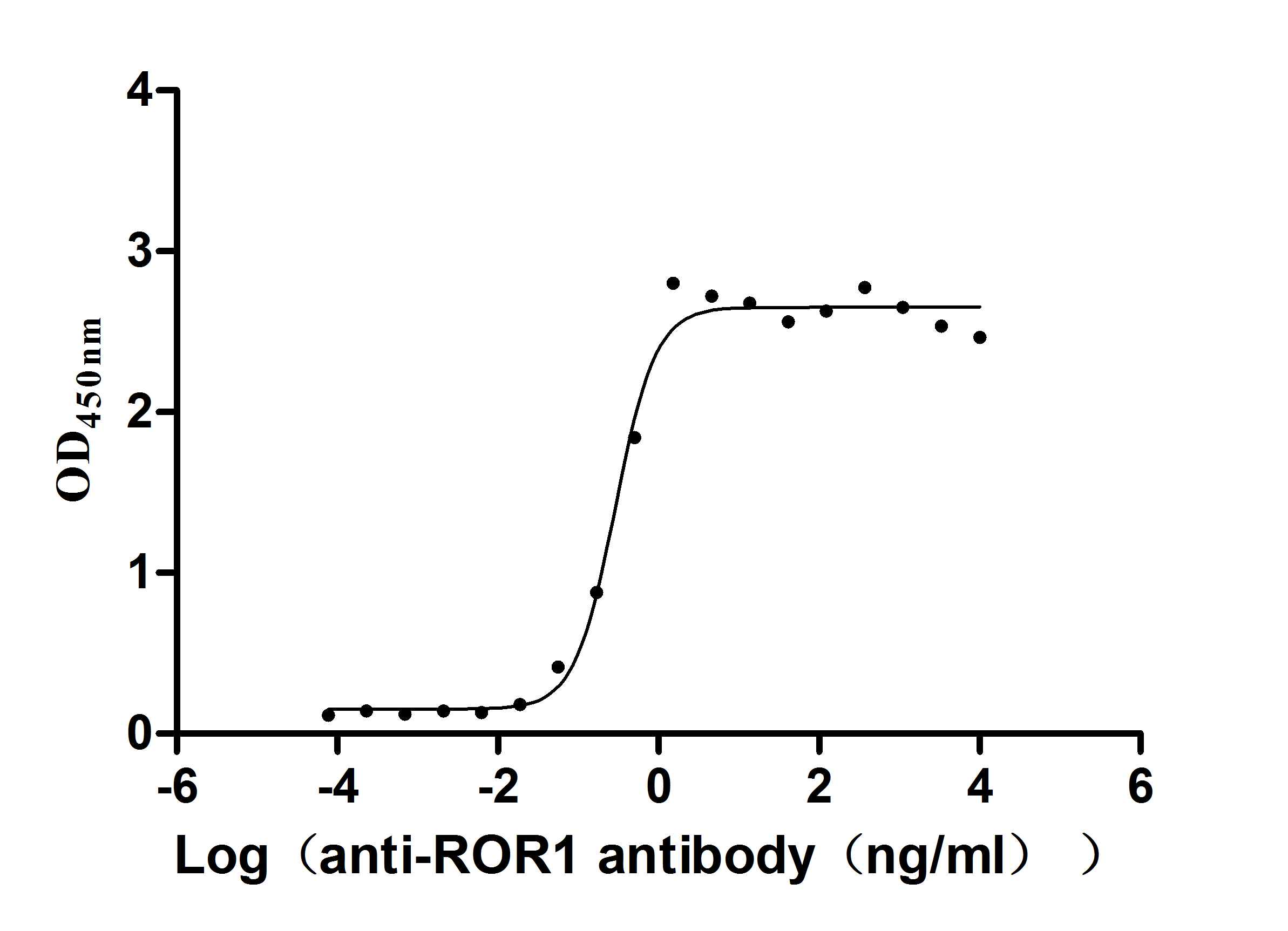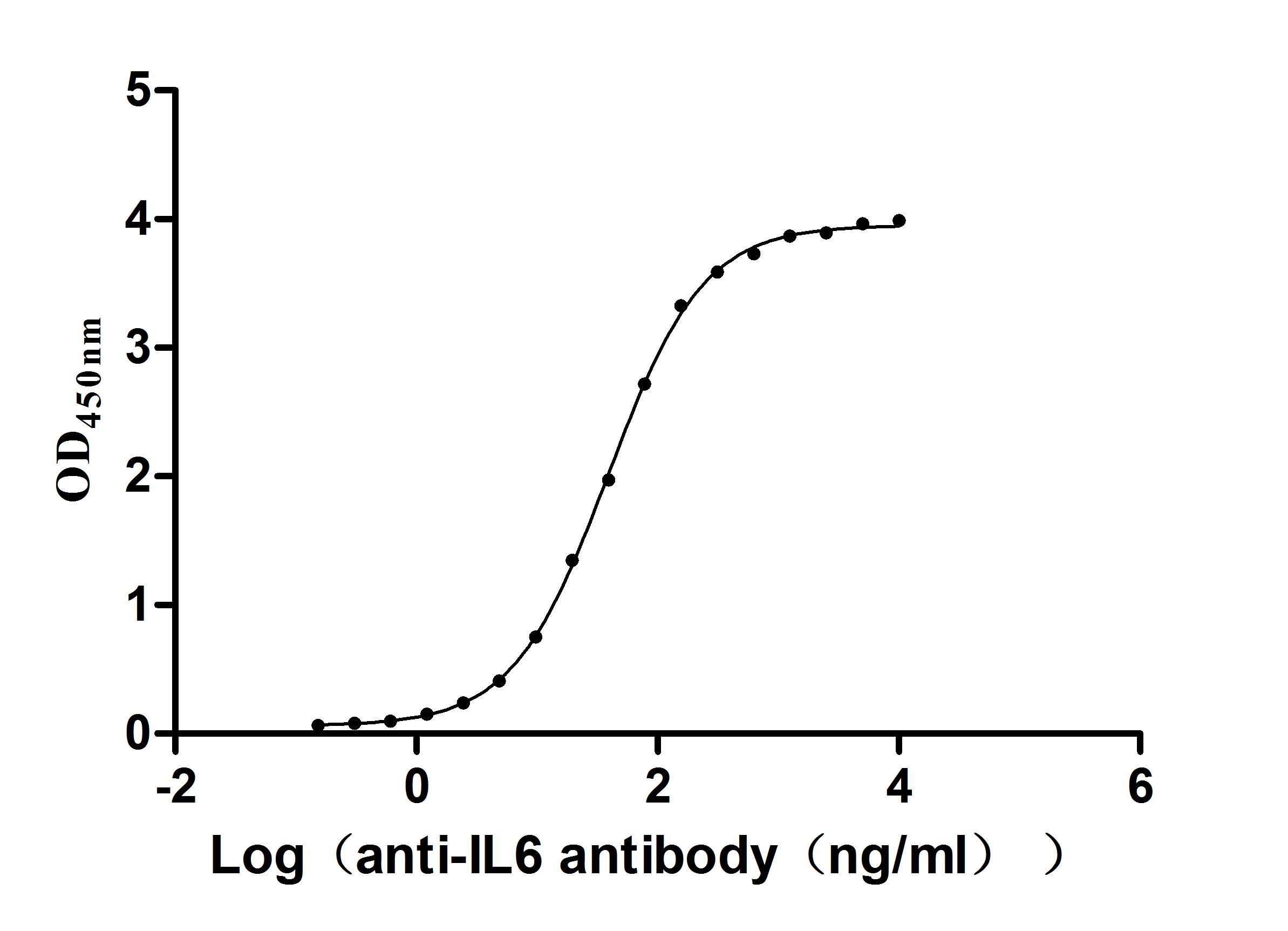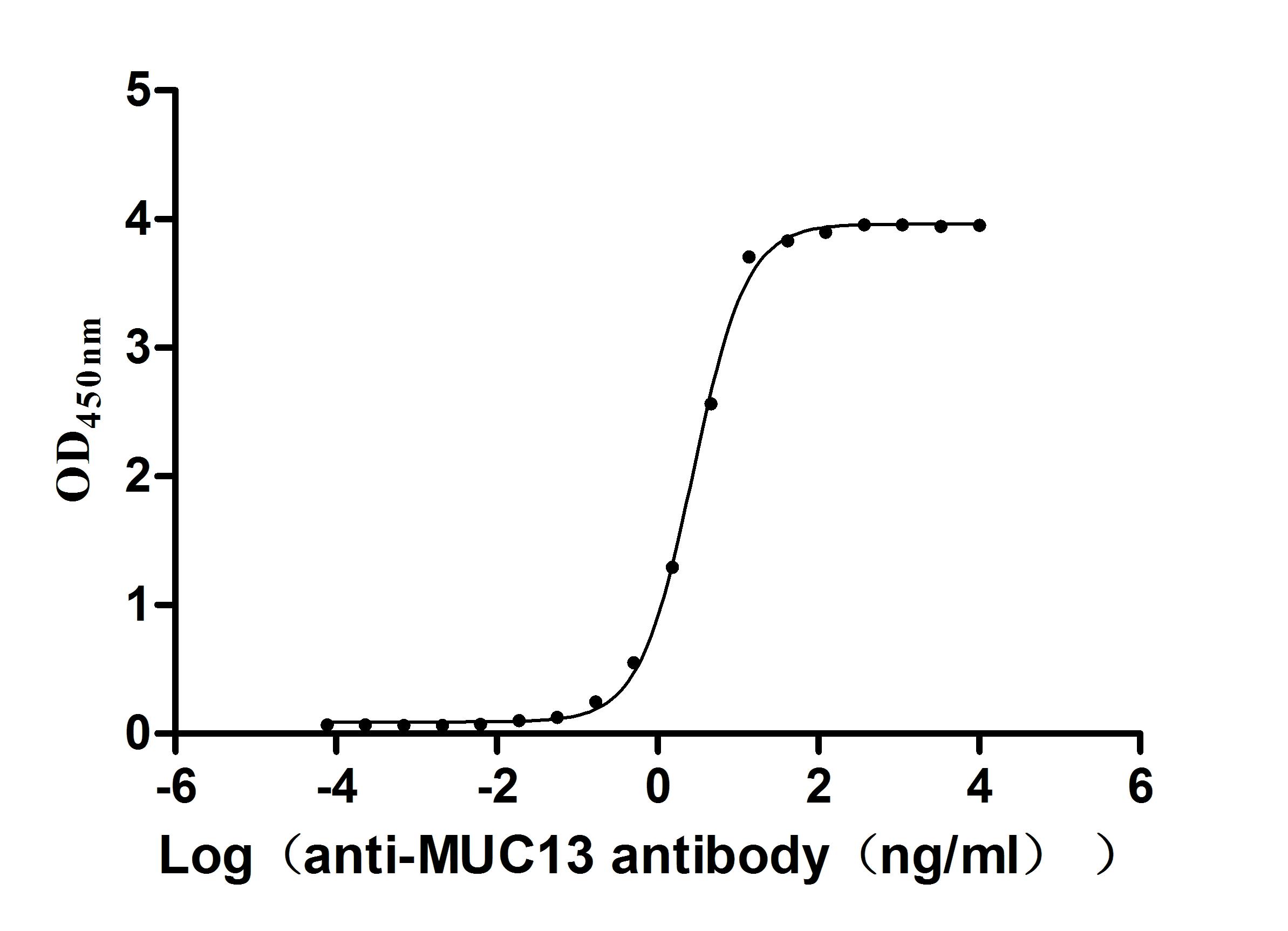Recombinant Rat Mu-type opioid receptor (Oprm1), partial
-
货号:CSB-YP016361RA1
-
规格:
-
来源:Yeast
-
其他:
-
货号:CSB-EP016361RA1
-
规格:
-
来源:E.coli
-
其他:
-
货号:CSB-EP016361RA1-B
-
规格:
-
来源:E.coli
-
共轭:Avi-tag Biotinylated
E. coli biotin ligase (BirA) is highly specific in covalently attaching biotin to the 15 amino acid AviTag peptide. This recombinant protein was biotinylated in vivo by AviTag-BirA technology, which method is BriA catalyzes amide linkage between the biotin and the specific lysine of the AviTag.
-
其他:
-
货号:CSB-BP016361RA1
-
规格:
-
来源:Baculovirus
-
其他:
-
货号:CSB-MP016361RA1
-
规格:
-
来源:Mammalian cell
-
其他:
产品详情
-
纯度:>85% (SDS-PAGE)
-
基因名:
-
Uniprot No.:
-
别名:Oprm1; Ror-b; Mu-type opioid receptor; M-OR-1; MOR-1; Opioid receptor B
-
种属:Rattus norvegicus (Rat)
-
蛋白长度:Partial
-
蛋白标签:Tag type will be determined during the manufacturing process.
The tag type will be determined during production process. If you have specified tag type, please tell us and we will develop the specified tag preferentially. -
产品提供形式:Lyophilized powder
Note: We will preferentially ship the format that we have in stock, however, if you have any special requirement for the format, please remark your requirement when placing the order, we will prepare according to your demand. -
复溶:We recommend that this vial be briefly centrifuged prior to opening to bring the contents to the bottom. Please reconstitute protein in deionized sterile water to a concentration of 0.1-1.0 mg/mL.We recommend to add 5-50% of glycerol (final concentration) and aliquot for long-term storage at -20℃/-80℃. Our default final concentration of glycerol is 50%. Customers could use it as reference.
-
储存条件:Store at -20°C/-80°C upon receipt, aliquoting is necessary for mutiple use. Avoid repeated freeze-thaw cycles.
-
保质期:The shelf life is related to many factors, storage state, buffer ingredients, storage temperature and the stability of the protein itself.
Generally, the shelf life of liquid form is 6 months at -20°C/-80°C. The shelf life of lyophilized form is 12 months at -20°C/-80°C. -
货期:Delivery time may differ from different purchasing way or location, please kindly consult your local distributors for specific delivery time.Note: All of our proteins are default shipped with normal blue ice packs, if you request to ship with dry ice, please communicate with us in advance and extra fees will be charged.
-
注意事项:Repeated freezing and thawing is not recommended. Store working aliquots at 4°C for up to one week.
-
Datasheet :Please contact us to get it.
相关产品
靶点详情
-
功能:Receptor for endogenous opioids such as beta-endorphin and endomorphin. Receptor for natural and synthetic opioids including morphine, heroin, DAMGO, fentanyl, etorphine, buprenorphin and methadone. Agonist binding to the receptor induces coupling to an inactive GDP-bound heterotrimeric G-protein complex and subsequent exchange of GDP for GTP in the G-protein alpha subunit leading to dissociation of the G-protein complex with the free GTP-bound G-protein alpha and the G-protein beta-gamma dimer activating downstream cellular effectors. The agonist- and cell type-specific activity is predominantly coupled to pertussis toxin-sensitive G(i) and G(o) G alpha proteins, GNAI1, GNAI2, GNAI3 and GNAO1 isoforms Alpha-1 and Alpha-2, and to a lesser extent to pertussis toxin-insensitive G alpha proteins GNAZ and GNA15. They mediate an array of downstream cellular responses, including inhibition of adenylate cyclase activity and both N-type and L-type calcium channels, activation of inward rectifying potassium channels, mitogen-activated protein kinase (MAPK), phospholipase C (PLC), phosphoinositide/protein kinase (PKC), phosphoinositide 3-kinase (PI3K) and regulation of NF-kappa-B. Also couples to adenylate cyclase stimulatory G alpha proteins. The selective temporal coupling to G-proteins and subsequent signaling can be regulated by RGSZ proteins, such as RGS9, RGS17 and RGS4. Phosphorylation by members of the GPRK subfamily of Ser/Thr protein kinases and association with beta-arrestins is involved in short-term receptor desensitization. Beta-arrestins associate with the GPRK-phosphorylated receptor and uncouple it from the G-protein thus terminating signal transduction. The phosphorylated receptor is internalized through endocytosis via clathrin-coated pits which involves beta-arrestins. The activation of the ERK pathway occurs either in a G-protein-dependent or a beta-arrestin-dependent manner and is regulated by agonist-specific receptor phosphorylation. Acts as a class A G-protein coupled receptor (GPCR) which dissociates from beta-arrestin at or near the plasma membrane and undergoes rapid recycling. Receptor down-regulation pathways are varying with the agonist and occur dependent or independent of G-protein coupling. Endogenous ligands induce rapid desensitization, endocytosis and recycling. Heterooligomerization with other GPCRs can modulate agonist binding, signaling and trafficking properties. Involved in neurogenesis.
-
基因功能参考文献:
- Study found that early life repetitive procedures, whether tactile or noxious, do affect the intensity of OPRM1-immunoreactivity in the superficial spinal cord dorsal horn after injury in adulthood, without affecting baseline expression. PMID: 29473323
- HDAC2 expression was upregulated during the course of chronic pancreatitis pain induction, while muopioid receptor activity in the thoracic spinal dorsal horn was significantly suppressed. PMID: 29257262
- results provide further evidence for the role of accumbens shell mu-opioid receptors but not kappa-opioid receptors in mediating reinforcing e ff ects of EtOH and in regulating EtOH consumption. PMID: 27508965
- Oprm1 expression and function are higher in the NAc of sedentary rats selectively bred rats for high voluntary running behavior than rats selectively bred rats for low voluntary running behavior. Findings suggest that inherent differences in Oprm1 action and downstream dopaminergic signaling may influence inherited physical activity behavior. PMID: 27743985
- Study demonstrates that in the rat model, endometriosis can be associated with a decrease in mu opioid receptors (MOR)immunoreactivity within neuronal compartments in addition to a shift in MOR and N-methyl-d-aspartate subunit receptor (NR1) receptor expression within the ventral periaqueductal gray. PMID: 27089914
- Results suggest that mu opioid receptor-induced suppression of excitatory propagation in the insular cortex is an underlying mechanism of the powerful analgesic effects of mu opioid receptor agonists. In contrast, delta opioid receptors may play a minor role in suppressing acute pain. PMID: 27246300
- The findings provide evidence for the existence of MOR on the cell membrane, sarcoplasmatic reticulum and mitochondria in left ventricular cardiomyocytes in rats. However, heart failure does not result in an altered expression of the cardiac MOR-opioid system. PMID: 26686371
- Data show that preconception exposure of morphine to female adolescent animals affects their offspring's response to morphine in a sex-specific manner, which may be mediated in part by differential expression of the mu opioid receptor in the nucleus accumbens and ventral tegmental area. PMID: 26700246
- findings indicate that G9a contributes critically to transcriptional repression of MORs in primary sensory neurons in neuropathic pain. G9a inhibitors may be used to enhance the opioid analgesic effect in the treatment of chronic neuropathic pain. PMID: 26917724
- Results suggested that the high nightly voluntary running distance expressed by female rats selectively bred for running motivation is mediated by increased endogenous mu-opioid receptor signaling in the nucleus accumbens PMID: 26044640
- Activation of the mu opioid receptor (MOR) causes GTP to bind to and to activate Go (alphaobetagamma) PMID: 26119705
- Smaller cardiovascular responses to stimulation of m1-opioid receptors by endomorphin-2 can be explained by lower expression of M1OR mRNA in the Medial Ncleus sSlitarius of Spontaneously Hypertensive Rats compared to Wistar Kyoto rats. PMID: 25051156
- mu-opioid and 5-HT1A receptors cooperatively act to regulate escape behaviour. PMID: 25315826
- K303. in the mu opioid (MOP) receptor is important in conferring selectivity for covalent binding of beta-funaltrexamine PMID: 25481857
- Study demonstrated that OPRM1 activation attenuated Abeta oligomers-induced neurotoxicity in primary cultured cortical neurons through mTOR signaling PMID: 25146548
- The results of this study suggested that upregulation of VTA MOR is necessary for the behavioral and biochemical changes induced by social defeat stress. PMID: 25446676
- This study demonistrated that EM2- and SP-containing terminals and GABAergic neurons in the mouse spinal dorsal horn. PMID: 24718557
- These results suggest a synergic interaction between the 5-HT1A and the mu-opioid receptor at post-synaptic level on neurons of the dorsal periaqueductal grey that regulate proximal defense, theoretically related to panic attacks. PMID: 23598399
- Our data demonstrate that mu-delta heteromer signaling does not desensitize and is regulated differently from mu- and delta-receptor signaling following prolonged morphine treatment. PMID: 24976397
- testosterone plays a key role in the regulation of mu-opioid receptor in trigeminal ganglia under inflammatory conditions PMID: 23801566
- Fever induced by HIV-glycoprotein 120 is regulated by mu-type opioid receptors. PMID: 24120859
- Data indicate 3-methoxythiophen-2-yl)methyl]({2-[(9R)-9-(pyridin-2-yl)-6-oxaspiro-[4.5]decan-9-yl]ethyl})amine (TRV130) as a selective, and G protein biased mu opioid receptor agonist. PMID: 24063433
- the association of FKBP12 with OPRM1 attenuates the phosphorylation of the receptor and triggers the recruitment and activation of PKCepsilon. PMID: 24113748
- Endomorphin 2 and mu-opioid receptor might be involved in both the homeostatic control and information transmission of micturition. PMID: 23671582
- Reduction of mu opioid receptor signaling attenuates cocaine and heroin seeking behavior. PMID: 23299095
- The truncated single transmembrane variants can dimerize with the full-length 7-TM mu-opioid receptor (MOR-1) in the endoplasmic reticulum, leading to increased expression of MOR-1 at the protein level. PMID: 23760268
- results implicate mu-opiate receptors s in the central nucleus of the amygdala in a positive regulation of sodium intake PMID: 23270855
- Activation of both mu and delta opioid receptors relieves both heat-induced and mechanically induced pain. PMID: 23843537
- miR-134 participated in inflammatory pain by balancing the expression of MOR1 in dorsal root ganglia PMID: 22865422
- Activated mu-opioid receptors are at least partly capable of turning pulmonary C-fiber-mediated, rapid-shallow breathing into an apneic state. PMID: 22796630
- A fragment flanking the 5'-end of the GABArho1 gene suffices to drive transcription in the inner nuclear layer of the retina during early postnatal development. PMID: 23106126
- In high drinking animals, the anticipation of ethanol is characterized by distinct behaviors, increased exploration and novelty-seeking, and by a specific neurochemical phenotype, greater expression of ENK and MOR within the medial prefrontal cortex. PMID: 22703995
- These results suggest that thioredoxin-1 maybe play a role in the actions of morphine. PMID: 22732447
- Suggest that opioids acting on mu-receptors in the rostral medullary raphe exert an excitatory modulation of hyperventilation induced by hypoxia. PMID: 21827637
- Ghrelin interacts with neuropeptide Y Y1 and opioid receptors to increase food reward PMID: 22210742
- A subset of rostral ventromedial medulla neurons expressing mu-opioid receptors contributes to the maintenance of thermal hyperalgesia in neuropathic pain. PMID: 21238509
- Mu opioid receptor activation has profound effects on the temporal integration between two primary excitatory pathways in CA1 hippocampal region. PMID: 21056047
- chronic ethanol drinking alters the ability of MOR to endocytose in response to opioid peptides, and consequently, promotes tolerance to the effects of opioids PMID: 21602922
- MOR was expressed in rat brain neostriatum in both the marginal division as well as in patches, but with different morphological characteristics. These differences in MOR immunoreactivity indicated potential functional differences between them. PMID: 21631922
- Activation of mu-opioid receptors in nucleus accumbens shell increased feeding on a sweetened-fat diet. PMID: 20562021
- mu-Opioid receptor stimulation in the nucleus accumbens elevates fatty tastant intake by increasing palatability and suppressing satiety signals. PMID: 21543633
- The identification of the rat exon 11 and its associated variants further demonstrated conservation of 5' splicing in OPRM1 genes among rodents and humans. PMID: 21255438
- Data suggest that multiple reproductive experiences influence both gene activity and kappa, mu, and delta opioid receptor expression in the periaqueductal gray. PMID: 20574683
- Glycosylation at the N53 site of the rat mu-opioid receptor does not influence the function of this receptor significantly. PMID: 20592872
- These findings demonstrate that delta-opioid receptor activation selectively inhibits inputs activated by icilin, whereas mu-opioid receptor activation has a more widespread effect on synaptic inputs to neurons in the superficial dorsal horn. PMID: 20977770
- Spinal cord MOR/KOR heterodimers represent a unique pharmacological target for female-specific pain control. PMID: 21041644
- Results suggest that modulation of the delta-opioid receptor 2, but not mu receptor, expression and its synaptic localization may constitute a viable therapeutic approach to disrupt morphine-induced conditioned responses. PMID: 20626460
- Data show that mu and kappa opioid receptors are expressed as mRNA and translated into specific receptor proteins on cardiac parasympathetic, sympathetic, and sensory neurons as potential binding sites for opioids. PMID: 20653037
- Coexistence of delta-opioid receptors and mu-opioid receptors in small dorsal root ganglia neurons is a basis for direct interaction of opioid receptors in modulation of nociceptive afferent transmission and opioid analgesia. PMID: 20615975
- These results suggest that in rat sphenopalatine ganglion neurons activation of M2 mAChR likely modulates mu (micro) opioid receptors transmission in the brain vasculature to adequately maintain cerebral blood flow. PMID: 19889856
显示更多
收起更多
-
亚细胞定位:Cell membrane; Multi-pass membrane protein. Cell projection, axon. Perikaryon. Cell projection, dendrite. Endosome.
-
蛋白家族:G-protein coupled receptor 1 family
-
组织特异性:Brain. Is expressed in the cerebral cortex, caudate putamen, nucleus accumbens, septal nuclei, thalamus, hippocampus, and habenula. Not detected in cerebellum.
-
数据库链接:
KEGG: rno:25601
STRING: 10116.ENSRNOP00000051290
UniGene: Rn.10118
Most popular with customers
-
Express system: Mammalian cell
Species: Homo sapiens (Human)
-
Recombinant Human Angiopoietin-2 (ANGPT2) (Active)
Express system: Mammalian cell
Species: Homo sapiens (Human)
-
Express system: Mammalian cell
Species: Macaca fascicularis (Crab-eating macaque) (Cynomolgus monkey)
-
Recombinant Human Claudin-6 (CLDN6)-VLPs (Active)
Express system: Mammalian cell
Species: Homo sapiens (Human)
-
-
Recombinant Human Mucin-13(MUC13),partial (Active)
Express system: yeast
Species: Homo sapiens (Human)



-AC1.jpg)

-AC1.jpg)












